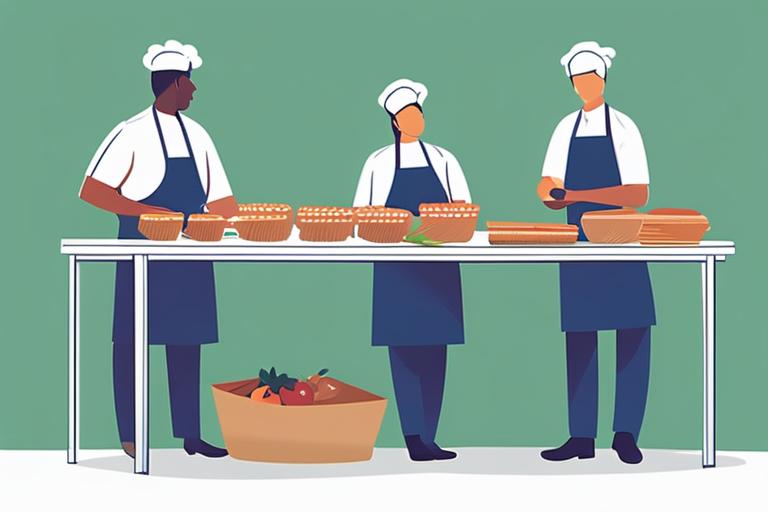
Volunteering at a Food Kitchen: A Guide to Making a Difference
Get Your Free Food Safety Cheat Sheet
30 most common foods with instant answers. Print it and stick it on your fridge—completely free!
Volunteering at a Food Kitchen: A Guide to Making a Difference
Are you looking for a meaningful way to give back to your community and help those in need? Volunteering at a food kitchen can be a rewarding experience that not only benefits others but also enriches your own life. In this guide, we will explore the ins and outs of volunteering at a food kitchen, including practical tips, safety information, and the impact you can make.
Why Volunteer at a Food Kitchen?
1. Making a Difference in the Community
- Volunteering at a food kitchen allows you to directly impact the lives of those who are struggling with food insecurity.
- Your time and effort can help provide nutritious meals to individuals and families in need, making a real difference in their lives.
2. Building Connections and Empathy
- Volunteering at a food kitchen exposes you to people from diverse backgrounds and circumstances, helping you develop empathy and understanding.
- You can forge meaningful connections with other volunteers and staff, creating a sense of community and camaraderie.
3. Personal Growth and Fulfillment
- Giving your time to help others can boost your self-esteem and sense of purpose.
- Volunteering at a food kitchen can also enhance your skills in communication, teamwork, and problem-solving.
How to Get Started as a Volunteer
1. Research Local Food Kitchens
- Start by researching food kitchens in your area and identifying ones that align with your values and schedule.
- Reach out to the organizations to inquire about volunteer opportunities and any requirements for participation.
2. Attend an Orientation or Training
- Many food kitchens require volunteers to attend an orientation or training session to familiarize themselves with the kitchen's protocols and procedures.
- Take this opportunity to ask questions, learn about food safety practices, and understand your role as a volunteer.
3. Be Prepared and Flexible
- Wear comfortable, appropriate clothing and closed-toe shoes when volunteering at a food kitchen.
- Be prepared to follow instructions from kitchen staff, adapt to changing tasks, and work efficiently in a fast-paced environment.
Food Safety Tips for Volunteers
1. Hand Hygiene
- Wash your hands thoroughly with soap and water before handling food or utensils.
- Use hand sanitizer frequently, especially after handling raw ingredients or touching surfaces.
2. Food Handling Practices
- Follow proper food handling practices, such as using separate cutting boards for raw meat and produce.
- Avoid cross-contamination by using clean utensils and surfaces when preparing and serving food.
3. Temperature Control
- Ensure that hot foods are kept at a safe temperature (above 140°F) and cold foods are refrigerated below 40°F.
- Use food thermometers to check the internal temperature of cooked dishes to prevent foodborne illnesses.
Conclusion
Volunteering at a food kitchen is a meaningful way to give back to your community, build connections, and experience personal growth. By following the tips and safety guidelines outlined in this guide, you can make a positive impact while ensuring the well-being of those you serve. Take the first step today and see how volunteering at a food kitchen can change lives, including your own.

Authoritative Food Safety References
These agencies and university labs inform every tip and health precaution we publish.
USDA FoodKeeper – Cold Storage Guidelines
Official refrigerator, freezer, and pantry timelines maintained by the U.S. Department of Agriculture.
Visit USDA FoodKeeperFDA Produce Safety Rule & Grower Guidance
Field-to-fridge handling practices that prevent contamination of fruits, vegetables, and leafy greens.
Visit FDA Produce SafetyCDC Foodborne Illness Prevention Hub
Surveillance-backed guidance on pathogens, symptoms, and steps to reduce foodborne illness risk.
Visit CDC Food SafetyUC Davis Postharvest Technology Center
University research detailing optimal storage atmospheres for produce after harvest.
Visit UC Davis PostharvestPenn State Extension – Home Food Preservation & Safety
Peer-reviewed extension bulletins on safe canning, chilling, and reheating practices.
Visit Penn State ExtensionHow can I volunteer at a food kitchen near me?
What are the requirements to volunteer at a food kitchen?
What tasks can I expect to do as a volunteer at a food kitchen?
Can I volunteer at a food kitchen as a group or with my company?
How can I ensure food safety while volunteering at a food kitchen?
Get Your Free Food Safety Cheat Sheet
30 most common foods with instant answers. Print it and stick it on your fridge—completely free! Want more? Upgrade to the complete guide with 70+ foods.
Scan your food directly and get instant safety info using our AI-powered camera feature.